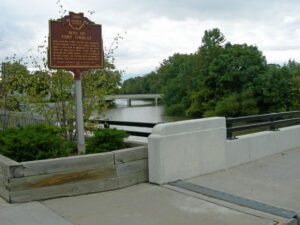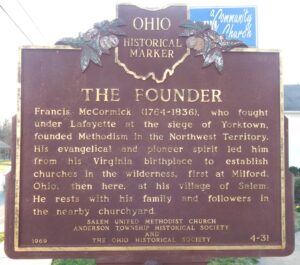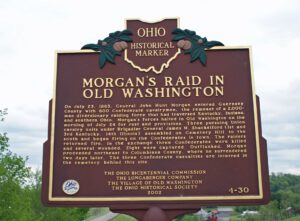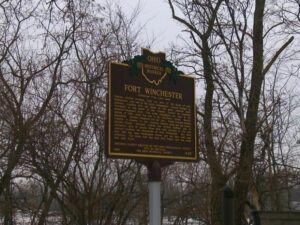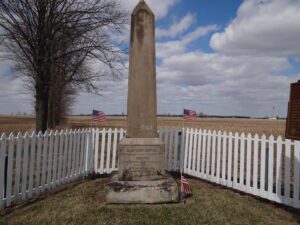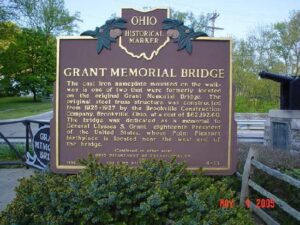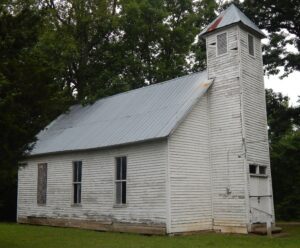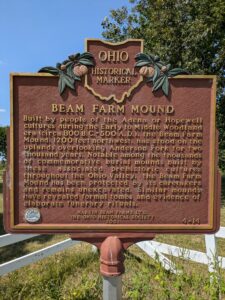, OH
Early in the War of 1812, Gen. Wm. Hull, commander of Ohio troops, ordered Col. James Findlay to open a road from Ft. McArthur on the Scioto River to Blanchard’s Fork. Under Findlay, a stockade 50 yards square, with a blockhouse at each corner, was erected here and named in his honor. The fort was used as a supply depot.
, OH
Francis McCormick (1764-1836), who fought under Lafayette at the siege of Yorktown, founded Methodism in the Northwest Territory. His evangelical and pioneer spirit led him from his Virginia birthplace to establish churches in the wilderness, first at Milford, Ohio, then here, at his village of Salem. He rests with his family and followers in the nearby churchyard.
, OH
On July 23, 1863, General John Hunt Morgan entered Guernsey County with 600 Confederate cavalrymen, the remnant of a 2,000-man diversionary raiding force that had traversed Kentucky, Indiana, and southern Ohio. Morgan’s forces halted in Old Washington on the morning of July 24 for rest and provisions. Three pursuing Union cavalry units under Brigadier General James M. Shackelford (1st and 3rd Kentucky, 14th Illinois) assembled on Cemetery Hill to the south and began firing on the Confederates in town. The raiders returned fire. In the exchange three Confederates were killed and several wounded. Eight were captured. Outflanked, Morgan proceeded northeast to Columbiana County, where he surrendered two days later. The three Confederate casualties are interred in the cemetery behind this site.
, OH
General William Henry Harrison ordered the construction of Fort Winchester at the beginning of October 1812 and it was completed October 15. The fort served as a forward observation post and supply depot for the American army during the War of 1812. Until Fort Meigs was completed in 1813, Fort Winchester was the front line against the British and their Indian allies. During the siege of Fort Meigs, Fort Winchester was a rendezvous point for the troops of General Green Clay and those of Colonel William Dudley. Fort Winchester outlined the shape of a parallelogram, measuring 600 by 300 feet in size. Blockhouses anchored the four corners of the fort and within its stockade were storehouses and a hospital.
, OH
On the banks of the Olentangy River, at the bend where the stream turns southwest, is the legendary site of Seccaium. This 17th century village was located on the portage to the Sandusky River, and was recognized by the Indians as a neutral ground for tribal councils where claims to hunting territories could be peacefully settled and goods could be traded. In the early 20th century, the site was an amusement park on the interurban electric railway.
, OH
The cast iron nameplate mounted on the walkway is one of two that were formerly located on the original Grant Memorial Bridge. The original steel truss structure was constructed from 1925-1927 by the Brookville Construction Company, Brookville, Ohio, at a cost of $62,192.60. The Bridge was dedicated as a memorial to General Ulysses S. Grant, eighteenth President of the United States, whose Point Pleasant birthplace is located near the west end of the bridge.
, OH
The present structure for the Macedonia Missionary Baptist Church was built in 1849 on Macedonia Ridge north of Burlington, an abolitionist sanctuary for escaped and freed slaves since 1799. It was built by the existing Baptist congregation and a group of 37 freed slaves who had arrived in Burlington from Virginia. The Baptist congregation in Macedonia had organized in 1811-1813 and practiced their faith in their homes and later in a small building with a bell tower made of sticks. The 1849 church was the religious and social focal point for the black community and became the “Mother Church” for approximately eight Baptist churches that exist in Ohio and West Virginia. The Macedonia Missionary Baptist Church was listed on the National Register of Historic Places in 1978.
, OH
Built by people of the Adena or Hopewell cultures during the Early to Middle Woodland era (circa 800 B.C – 500 A.D), the Beam Farm Mound, 1200 feet northwest, has stood on the uplands overlooking Anderson Fork for two thousand years. Notable among the thousands of commemorative burial mounds built by these associated prehistoric cultures throughout the Ohio Valley, the Beam Farm Mound has been protected by its caretakers and remains unexcavated. Similar mounds have revealed formal tombs and evidence of elaborate funerary rituals.


